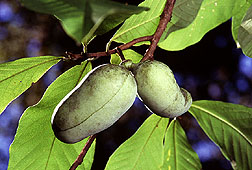Pawpaws Making a Comeback
|
|
One day soon you might find yourself enjoying one of Mark Twain's and Daniel Boone's favorite fruits, the pawpaw. That is, if plans by Kentucky State University (KSU), USDA's Agricultural Research Service, and the nonprofit PawPaw Foundation succeed.
"Pawpaws are our largest native fruit," says ARS horticulturist Kim E. Hummer. Like their South American cousins, the cherimoya and custard apple, pawpaws make a nutritious, sweet dessert or fruit drink."
Soft, thin skins and large seeds hinder processing and distribution and have kept a commercial industry from developing. But R. Neal Peterson, a USDA economist and pawpaw hobbyist, started a Maryland-based foundation that has helped renew interest in pawpaws. KSU’s Desmond R. Layne is leading efforts to commercialize pawpaw production, with help from ARS scientists.
Hummer directs research and is curator of the ARS National Clonal Germplasm Repository in Corvallis, Oregon. This facility is part of a national system to protect the diversity of crop plants.
Hummer and Layne have linked up the KSU pawpaw program as a satellite germplasm repository to the ARS facility in Corvallis.
Researchers in Corvallis and Kentucky are studying in vitro propagation, tissue culture, and cryopreservation of the fruit.
Hummer's laboratory, in conjunction with Oregon State University, is also participating in a regional variety trial of 28 existing pawpaw cultivars.
"Universities in more than a dozen states are cooperating on this project. Most of the locations are in the pawpaw’s native range of the eastern and midwestern parts of the United States,” Hummer says. Though the fruit never grew wild in Oregon, she says Corvallis has a compatible climate and expects the newly planted trees to grow well. Layne and Peterson codirect the trial.
Layne expects pawpaws to be commercially available within the next decade.
"It will take some time to test out varieties, determine the best processing methods, and educate consumers," Layne says. "But the public interest is staggering. Last year alone, I received more than 2,000 requests for information."
And interest in pawpaws is developing worldwide. "We have had requests for pawpaw germplasm from Japan, Germany, and the Slovakian Republic, among others," adds Hummer.
To answer this information need, ARS’ National Agricultural Library is collecting scientific and nontechnical publications on pawpaws and helping Layne develop a World Wide Web site and CD-ROM.— By Kathryn Barry Stelljes,
Kim E. Hummer is at the USDA ARS National Clonal Germplasm Repository, Corvallis, OR; phone (541) 738-4201.







